Hassani S. Mathematical Physics: A Modern Introduction to Its Foundations
Подождите немного. Документ загружается.

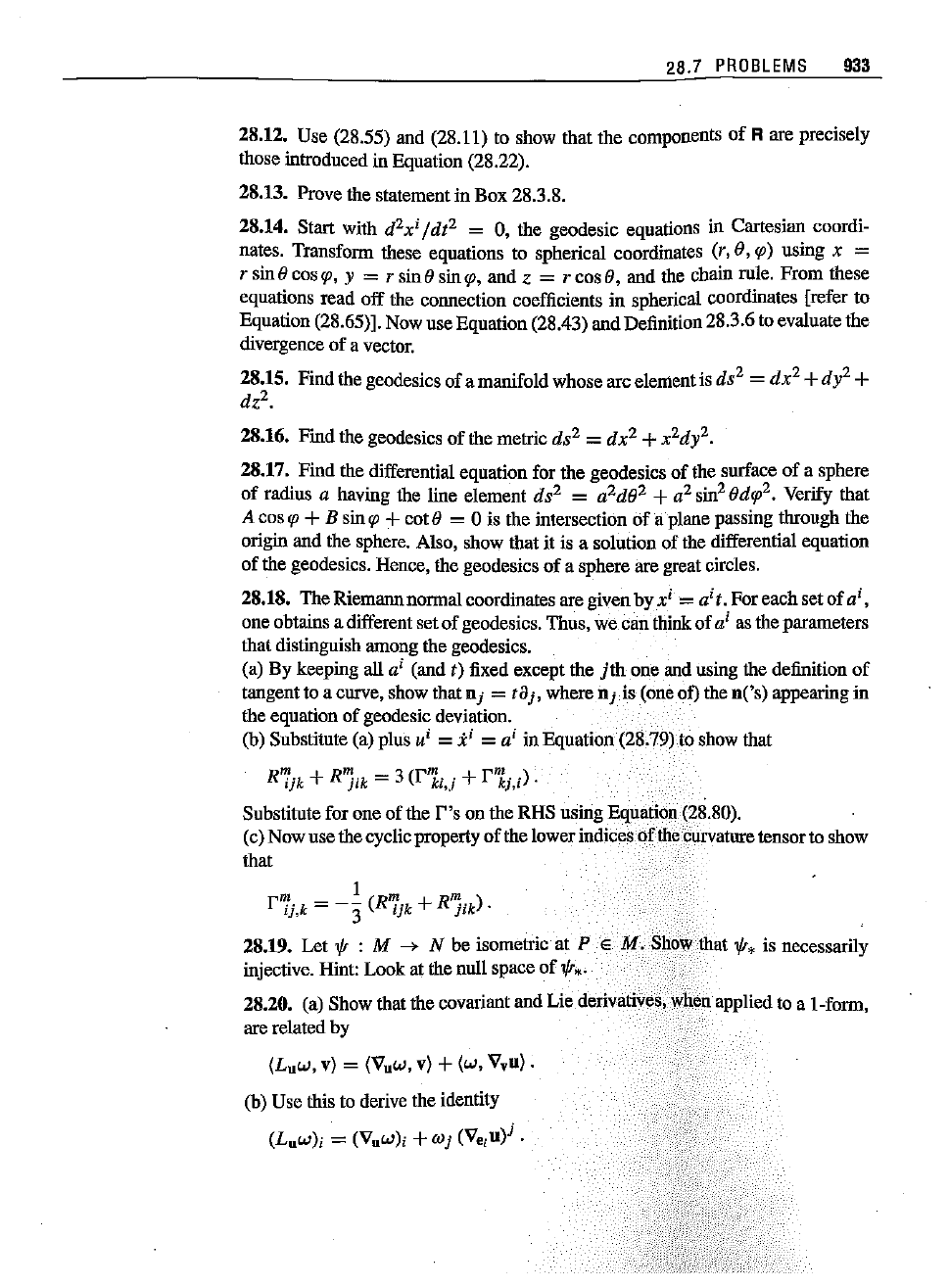
28.7
PROBLEMS
933
28.12. Use (28.55) and (28.11) to show that the components
of
R are precisely
those introduced in Equation (28.22).
28.13. Prove the statementin
Box
28.3.8.
28.14. Start with
d
2x
i
/dt
2
= 0, the geodesic equations in Cartesian coordi-
nates. Transform these equations to spherical coordinates
(r, II,
rp)
using x =
r sin II cos
rp,
y = r sin IIsin
rp,
and z = r cos II, and the chain rule. From these
equations read off the connection coefficients in spherical coordinates [refer to
Equation (28.65)]. Now use Equation(28.43) and Definition 28.3.6 to evaluate the
divergence
of a
vector.
28.15. Find the geodesics of a manifold whose arc elementis ds
2
=
dx
2
+d
y2
+
dz
2
•
28.16. Find the geodesics
of
the metric ds
2
= dx
2
+x
2d
y2.
28.17. Find the differential equation for the geodesics of the surface of a sphere
of
radius a having the line element ds
2
= a
2dll2
+a
2
sm2
IIdrp2.
Verify that
A cos
rp
+B sin
rp
+cot II = 0 is the intersection of a plane passing through the
origin and the sphere. Also, show that it is a solution of the differential equation
of the geodesics. Hence, the geodesics
of
a sphere are great circles.
28.18. The Riemannnormal coordinates are givenby
xi
= a
i
t. For eachset of a
i
,
one obtains a different set of geodesics. Thus, we can think of a
i
as the parameters
that distinguish among the geodesics.
(a) By keeping
all a
i
(and
t)
fixed except the
jth
one and using the definition
of
tangent to a curve, show that
nj
=
taj,
(one of) the nCs) appearing in
the equation of geodesic deviation.
(b) Substitute (a) plus u
i
=
xi
= a
i
in show that
R'ijk +
R'jik
= 3
(rki,,i
+
rkj,i)'
Substitute for one of the
P's
on the RHS using Equation
\""O,.OUI).
(c) Now use the cyclic property of the curvature
tensor
to
show
that
r"!· k =
-~
(R"!'k +
Rn~'k)'
I},
3
I}
JI
28.19. Let
Vr
: M --> N be isometric at
injective. Hint: Look at the null space
of
Vr
•.
28.20. (a) Show that the covariant and
are related by
(Luw, v) = (Vuw, v) +(w, Vvu) .
(b) Use this to derive the identity
(LuW)i = (VuW)i +w,i
(V
ei
u),i .
Vr.
is necessarily
appuen
to a l-form,
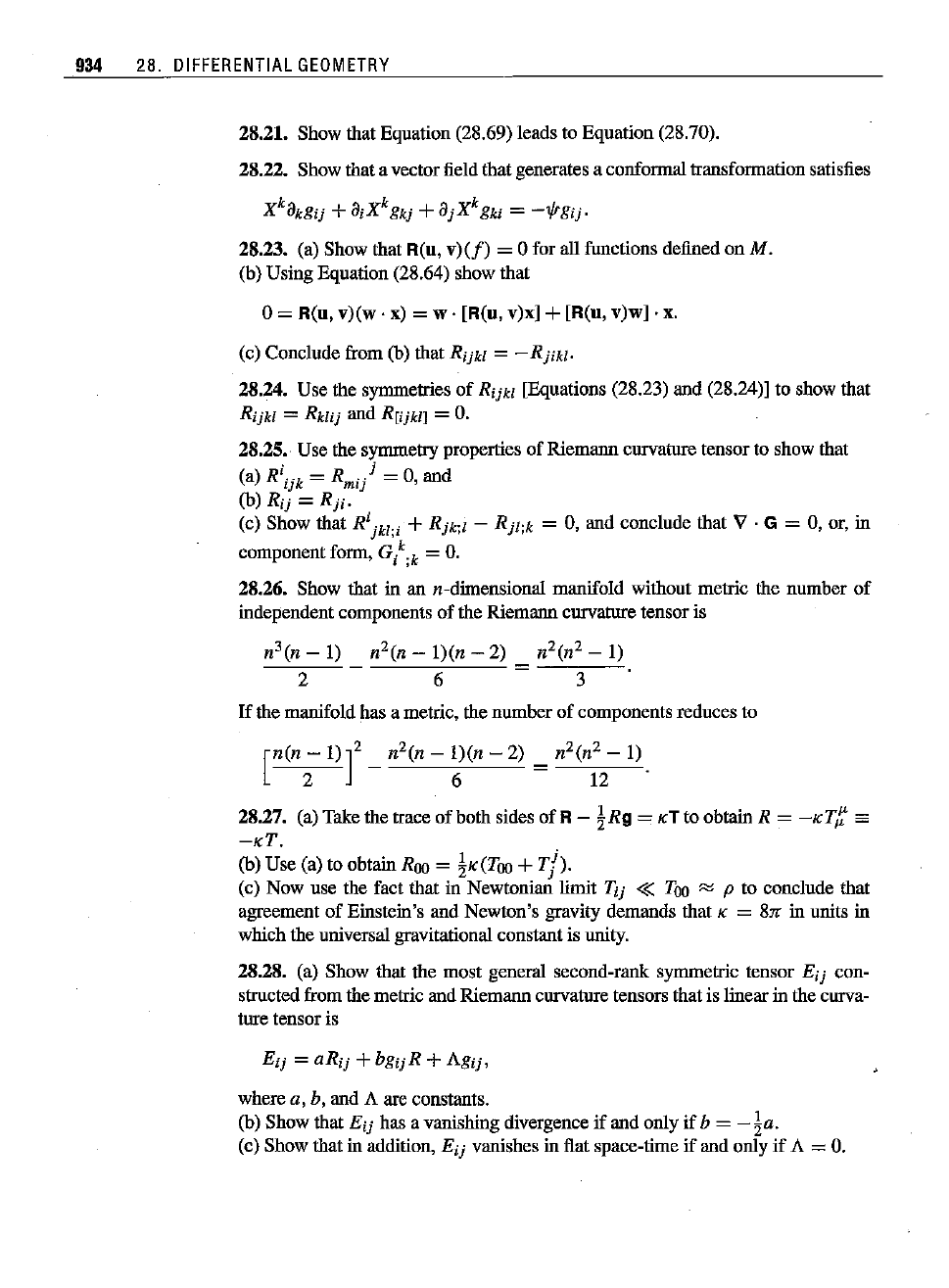
934 28.
DIFFERENTIAL
GEOMETRY
28.21. Show that Equation (28.69) leads to Equation (28.70).
28.22. Show that a vector field that generates a conformal transformation satisfies
Xk8kgij
+
8iXkgkj
+
8jX
kgki
=
-1{rgij.
28.23. (a) Show that R(u,
v)(f)
= 0 for all functions defined on
M.
(b) Using Equation (28.64) show that
0=
R(u,
v)(w·
x) = w- [R(u, v)x] +[R(u, v)w] . x.
(c) Conclude from
(b) that
Rijkl
=
-Rjikl.
28.24. Use the symmetries
of
Rijkl
[Equations (28.23) and (28.24)] to show that
Rijkl
=
Rklij
and
R[ijkll
=
O.
28.25.· Use the symmetry properties of Riemann curvature tensor to show that
(a)
R
i
ij k
= R
m
./
=0, and
(b)
Rij
=
Rji.
(c) Show that
Rijkl;i
+
Rjk;l
-
Rjl;k
= 0, and conclude that V . G = 0, or, in
componentform,
or;
=
O.
28.26. Show that in an n-dimensional manifold without metric the number
of
independent
components
of the
Riemann
curvature
tensor
is
If
the manifold has a metric, the number of components reduces to
28.27. (a) Take the trace of both sides
ofR-
!Rg
=KTtoobtainR
=
-KT/:
ea
-KT.
(b) Use (a) to obtain Roo= !K(Too +
Tj).
(c) Now use the fact that in Newtonian limit Tij «
Too'"
P to conclude that
agreement of Einstein's and Newton's gravity demands that
K = 8". in units in
which the universal gravitational constant is unity.
28.28. (a) Show that the most general second-rank symmetric tensor
Eij
con-
structed from the metric and Riemann curvature tensors that is linear in the curva-
ture
tensor
is
wherea, b, andA
are
constants.
(b) Show that
Eij
has a vanishing divergence
if
and only
if
b =
-!a.
(c) Show that in addition,
Eij
vanishes in flat space-time
if
and only
if
A =
O.
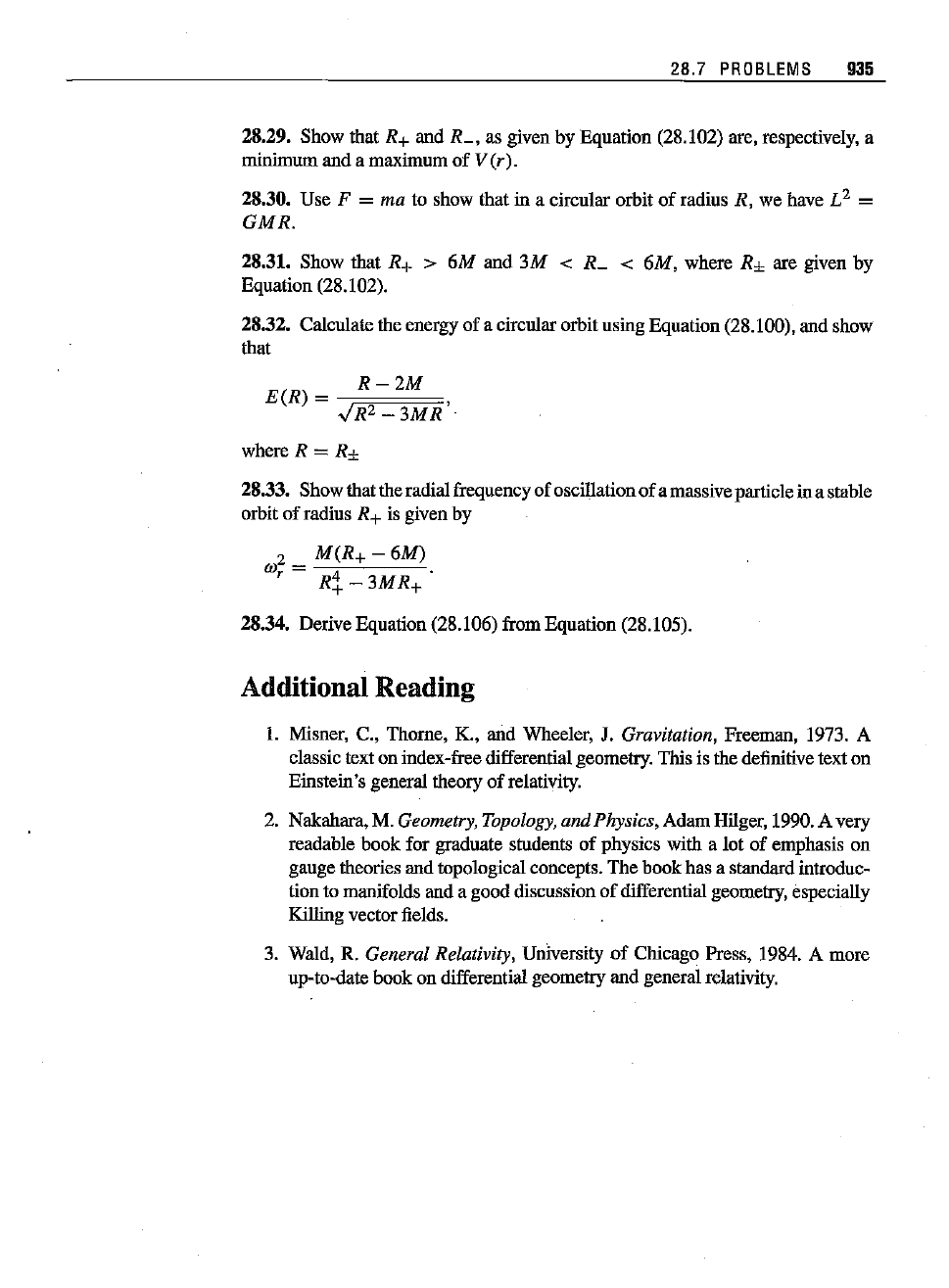
2B.7
PROBLEMS
935
28.29. Show that R+ and
R_,
as given by Equation (28.102) are, respectively, a
minimum and a maximum
of
V
(r).
28.30. Use F = ma to show that in a circular orbit
of
radius R, we have L
2
=
GMR.
28.31. Show that R+ > 6M and 3M < R_ < 6M, where R± are giveu by
Equation (28.102).
28.32. Calculate the energy of a circular orbit using Equation (28.100), and show
that
R-2M
E(R)
= ,
../R2_3MR
whereR
= R±
28.33. Show that theradial frequency of oscillatiou
of
amassive particlein a stable
orbit of radius R+ is given by
2 M(R+
-6M)
lV
r
=
R:j.
_ 3MR+ .
28.34. Derive Equation (28.106) from Equation (28.105).
Additional Reading
1. Misner, C., Thome, K., and Wheeler, J. Gravitation, Freeman, 1973. A
classic text on index-freedifferential geometry. This is the definitive text on
Einstein's general theory
of
relativity.
2. Nakahara, M. Geometry,Topology, and Physics, Adam Hilger, 1990. A very
readable book for graduate students of physics with a lot of emphasis on
gauge theories and topologicalconcepts. The bookhas a standard introduc-
tion to manifolds and a good discussion
of
differential geometry, especially
Killing vector fields.
3. Wald, R.
General Relativity, Uoiversity
of
Chicago Press, 1984. A more
up-to-date book on differential geometry and general relativity.
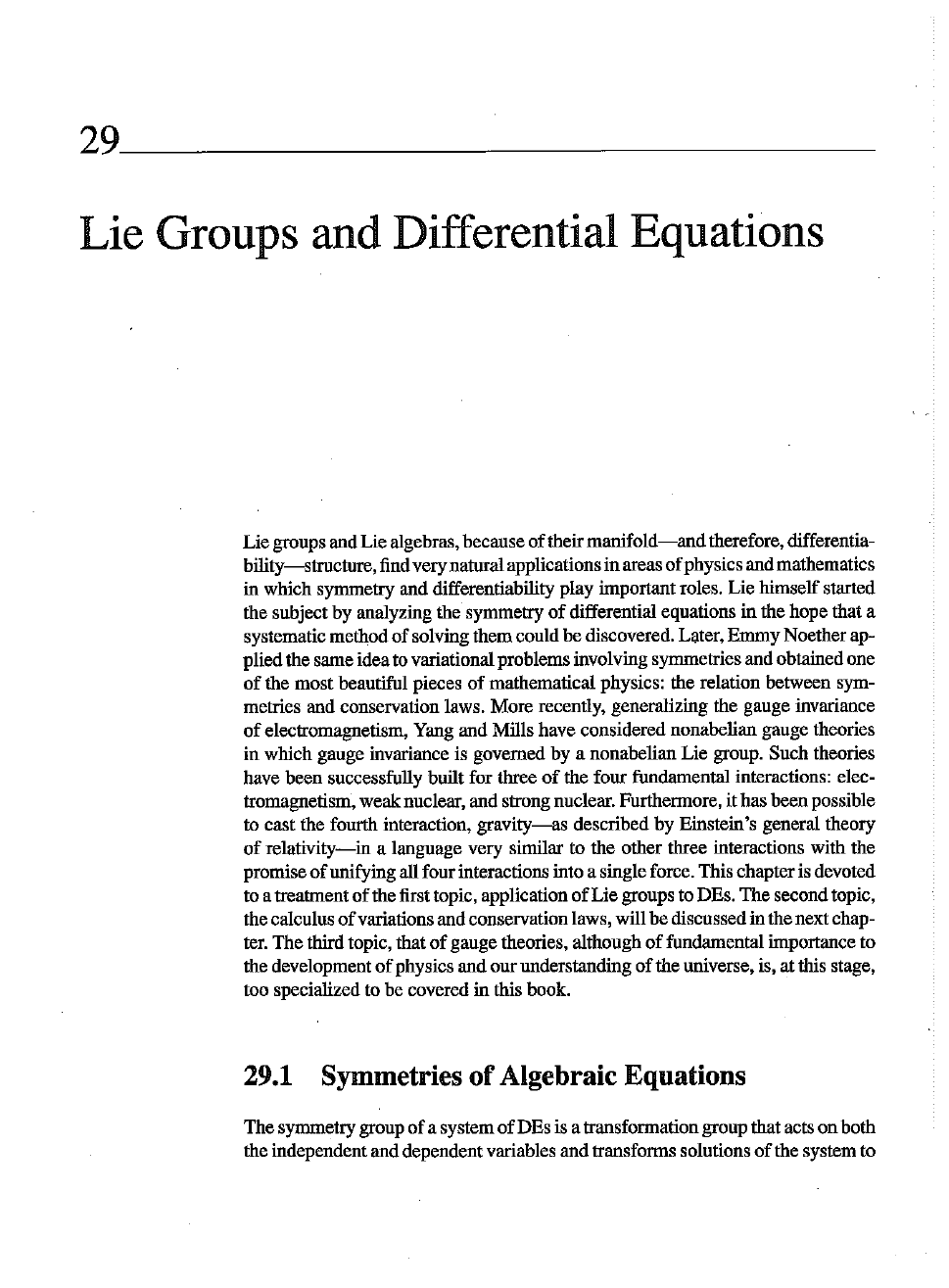
29,
_
Lie
Groups
and
Differential
Equations
Lie groups and Lie algebras,because of their
manifold-and
therefore, differentia-
bility-structure,
findvery naturalapplicationsin areas ofphysicsand mathematics
in which symmetry and differentiability play importantroles. Lie himselfstarted
the subject by analyzing the symmetry
of
differential equations in the hope that a
systematic methodof solving them could be discovered. Later,
Emmy
Noether ap-
pliedthe same idea to variationalproblems involving symmetriesand obtainedone
of
the most beautiful pieces of mathematical physics: the relation between sym-
metries and conservation laws. More recently, generalizing the gauge invariance
of
electromagnetism, Yang and Mills have considered nonahelian gauge theories
in which gauge invariance is governed by a nonahelian Lie group. Such theories
have been successfully built for three
of
the four fundamental interactions: elec-
tromagnetism, weaknuclear, and strong nuclear. Furthermore, it has beenpossible
to cast the fourth interaction,
gravity-as
described by Einstein's general theory
of
relativity-in
a langnage very similar to the other three interactions with the
promiseofnnifying
allfour interactions into a single force. This chapteris devoted
to a treatment
of
the first topic, application
of
Lie groups to DEs. The secondtopic,
the calculus
of
variations and conservationlaws, will be discussedin the next chap-
ter. The third topic, that
of
gauge theories, although of fundamental importance to
the development
of
physics and our understanding of the universe, is, at this stage,
too specialized to be covered in this book.
29.1 Symmetries
of
Algebraic Equations
The symmetry group of a system
of
DEs is a transformationgroupthat acts on both
the independentand dependentvariables and transforms solutions
of
the system to

G-invariance
and
symmetry
group
defined
29.1 SYMMETRIES
OF
ALGEBRAIC
EQUATIONS
937
other solutions.
In
order to understandthis symmetry group,we shall firsttackle
the simplerquestionof the symmetriesof a systemof
algebraic equations.
29.1.1.Definition.
Let G be a local Lie group
of
transformations acting on a
manifold
M. A subset
ScM
is called G-invariant and G is called a symmetry
group
of
S
if
whenever g . P is defined
for
PES
and g E G, then g .
PES.
29.1.2.Example. LetM =
1Il
2
.
(a) Let G = lR+be the abelian multiplicative group
of
real numbers.
Let
it act on M
componentwise:r- (x,
y)
=
(rx,
ry).
Thenanyline goingthroughtheoriginisa G-invariant
subset of]R2.
(b)
If
G =
80(2)
and it acts on M as usual, then any circle is a G-invariant subset
of
~.
.
A system
of
algebraic equations is a systemof equations
system
of
algebraic
equations
and
their
symmetry
group
Fv(x)
= 0,
v=1,2,
...
,n,
iowhich
F;
: M
--+
IR
is smooth.Asolutionis apoiotx E M suchthat F
v
(x)
= 0
for
v = I,
...
, n. The solution set of the system is the collectionof all solutions.
A Lie group G is called a symmetry group of the system
if
the solution set is
G-iovariant.
invariant
map
29.1.3.Definition. Let G be a local Lie group
of
transformations acting on a
manifold M. A map F : M
--+
N,
where N is another manifold, is called a
G-invariant map
if
for
all P E M
and
all g E G such that g . P is defined,
F(g. P) = F(P).A real-valuedG-invariantfunction iscalledsimply an invariant.
The crucialpropertyof Lie grouptheoryis that locallythe group and its alge-
bra "look alike." This allows the complicated nonlinear conditions
of
invariance
of subsetsand functionsto be replacedby the simplerlioear conditionsof iovari-
anceunderinfinitesimalactions.FromDefinition
27.1.25, we obtaiothe
following
proposition.
29.1.4.Proposition.
Let
G be a local group
of
transformations acting on a man-
ifold M. A smooth real-valuedfunction f : M
--+
IR
is G-invariant
if
and
only
if
forall
P E M
(29.1)
andfor
every infinitesimal generator eE g.
29.1.5.Example. The
iofinitesimal
generator
for
80(2)
iseM =
x8
y
- y8
x
.
Any
func-
tionofthe
form
f (x
2
+
y2)
isan
80
(2)-iovatiant.
To
see
this,
we
apply
Proposition
29.1.4:
(x8
y
- y8
x)f(x
2
+
y2)
=
x(2y)f'
-
y(2x)!,
=0,
where
/'
is the derivative
of
f.
•
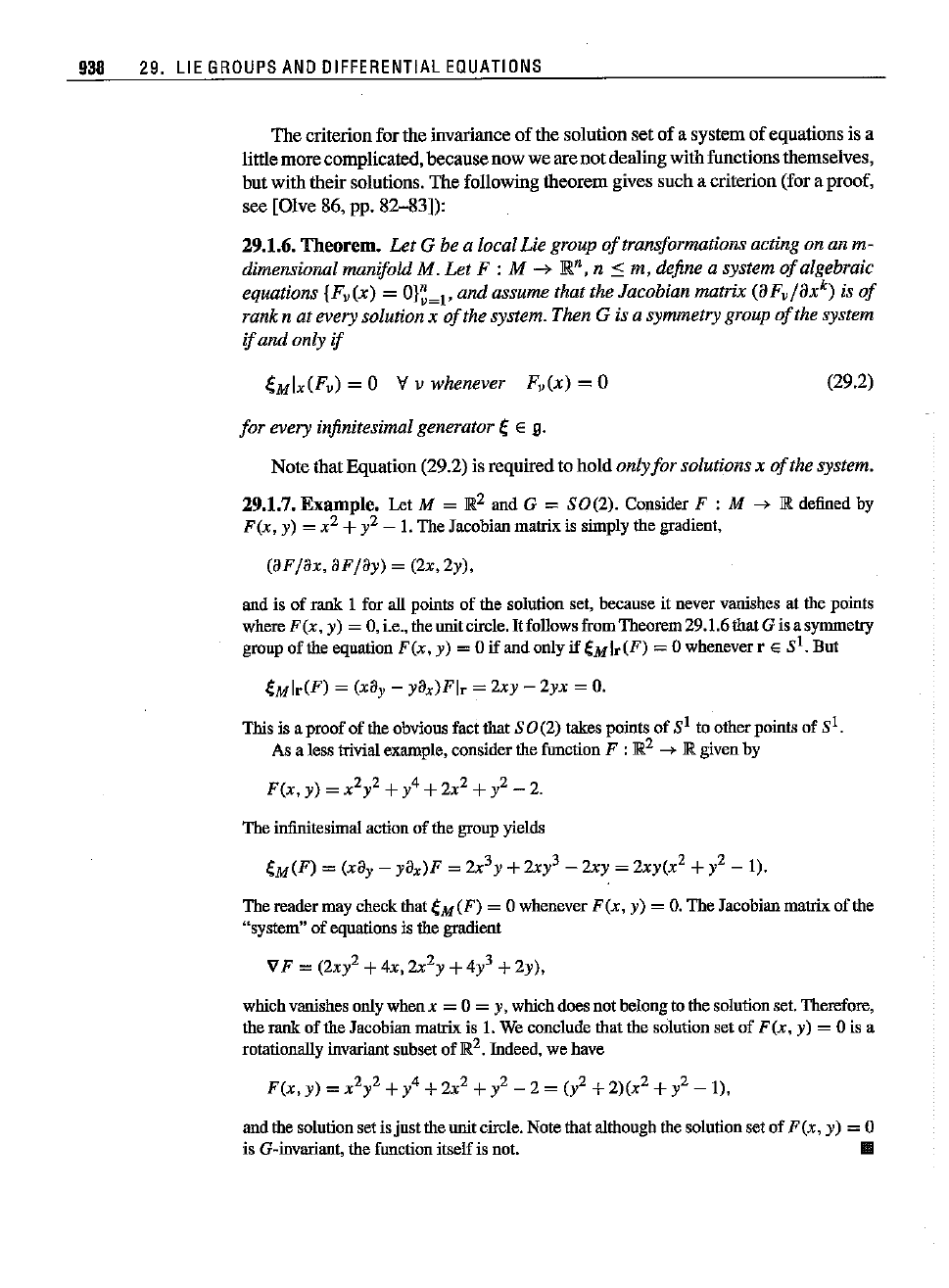
938
29. LIE
GROUPS
AND
DIFFERENTIAL
EQUATIONS
The
criterionfor
the
invariance
of
the
solution
set
of
a
system
of
equations is a
little
more
complicated,
because
now
we
are
not
dealing
with
functions themselves,
but
with
their
solutions.
The
following
theorem
gives
such
a criterion
(for
a proof,
see [Olve 86,
pp.
82-83]):
29.1.6.Theorem.
Let
G be a local Lie group
of
transformations acting on an m-
dimensional manifold M.
Let
F : M
->
En, n
:s
m, define a system
of
algebraic
equations {Fv(x) =
O}~~l'
and
assume that the Jacobian matrix
(8F
vI8x
k
) is
of
rank n at every solution x
of
the system. Then G is a symmetry group
of
the system
if
and
only
if
(29.2)
for
every infinitesimal generator eE
D.
Note
that
Equation
(29.2) is
required
to
hold
only
for
solutions x
of
the system.
29.1.7.Example. Let M =
1R
2
and G =
SO(2).
Consider F : M
-+
IR
defined by
F(x, y) = x
2
+ y2 -
I.
The Jacnbian matrix is simply the gradient,
(8F
lax,
8F
lay)
= (2x, 2y),
andis of
rank
1 for all pointsof the solutionset, becauseit nevervanishes atthepoints
where F(x, y) = O,i.e.,thennitcircle.
It
followsfromTheorem 29.1.6thatG isa symmetry
group of the equation
F(x,
y) =0
if
and only
if
f;Mlr(F)
=0 whenever
rESt.
But
f;Mlr(F)
= (xa
y
- y8
x)Flr
=
2xy
-
2yx
=
O.
Tbis is a proof of the obviousfact that
SO
(2) takes points of St to other points of S1.
As alesstrivial
example,
consider
the
function
F :
]R2
---+
.IR
givenby
F(x,
y)
=x
2
i +
y4+
2x2
+ y2
-2.
Theinfinitesimal actionof the
group
yields
The reader may check that
f;M(F)
= 0 whenever
F(x,
y) =
O.
The Jacobian matrix of the
"system"
of
equations
isthe
gradient
which
vanishes
onlywhenx = 0 = y.
which
doesnotbelongtothe
solution
set.
Therefore,
the
rank
of the
Jacobian
matrix
is 1.We
conclude
that
the
solution
setof F(x, y) = 0 is a
rotationally
invariant
subset
of]R2.
Indeed,
we have
andthesolution setisjustthe
unitcircle.Notethat
although
thesolutionsetof F(x, y) =0
is
G-invariant,
the
function
itselfis not.
II1II
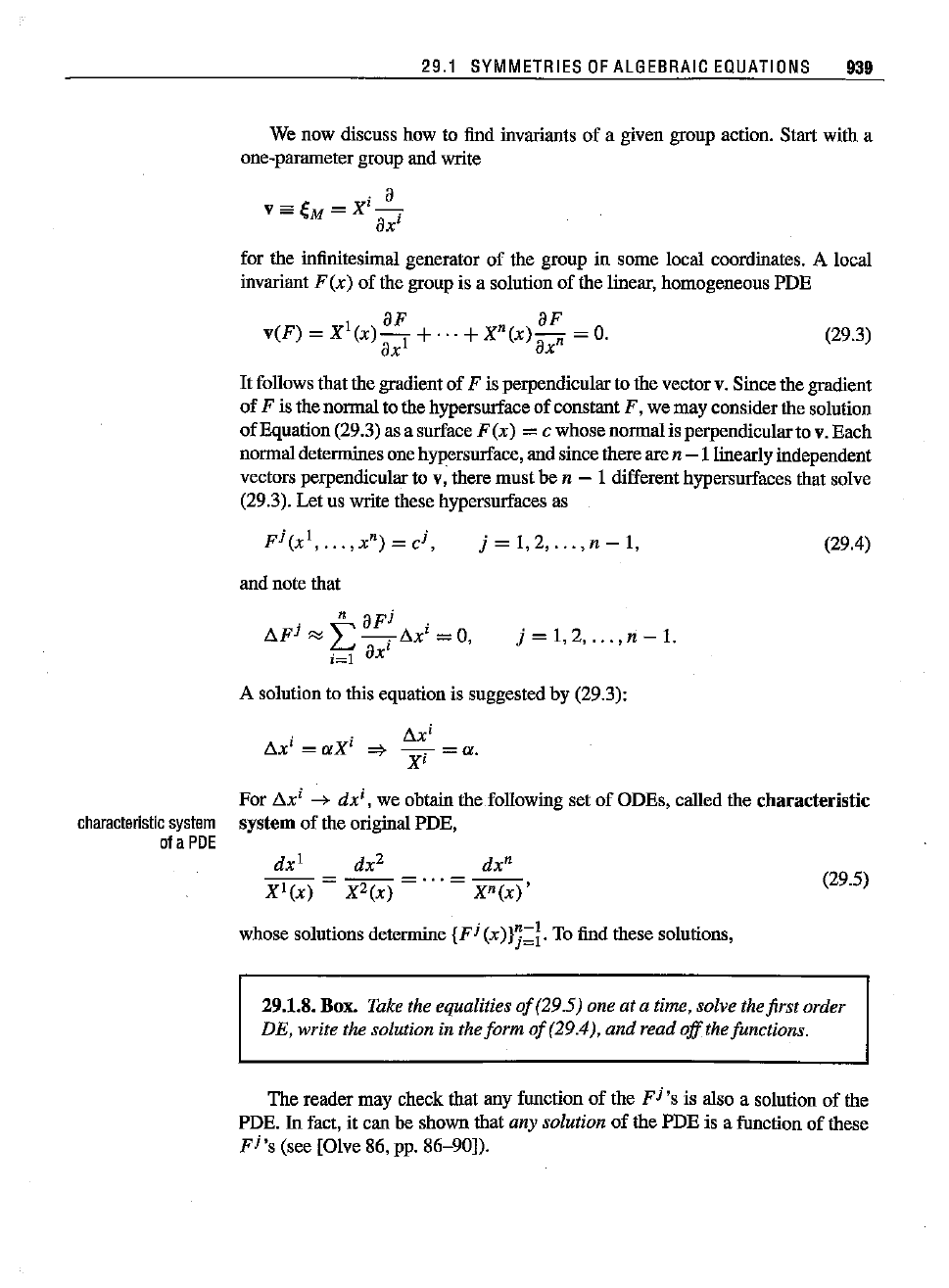
(29.3)
29.1 SYMMETRIES
OF
ALGEBRAIC
EQUATIONS
939
We now discuss how to find invariants of a given group action. Start with a
one-parametergroup and write
. a
v=eM=X'-.
ax'
for the infirtitesimal generator of the group in some local coordinates. A local
invariant
F(x)
of the group is a solution of the linear, homogeneous POE
aF aF
v(F)
= Xl
(x)-l
+...+
Xn(x)-n
=
o.
ax ax
It
follows that the gradient of F is perpendicular to the vector v. Since the gradient
of
F is the normalto the hypersurface
of
constant F, we may considerthe solution
of
Equation(29.3) as a surface
F(x)
= c whose normalis perpendicularto v. Each
normaldetermines one hypersurface, and since thereare
n
-I
linearlyindependent
vectors perpendicularto v, there must
he n - I different hypersurfaces that solve
(29.3). Let us write these hypersurfaces as
and note that
. n
aFi
.
6.FJ "" L --.6.x' = 0,
i=l
ax'
j = 1,2,
...
,n - 1,
j = 1,2,
...
,n - 1.
(29.4)
A solution
to this equation is suggested by (29.3):
!::::.
i_xi
!::::.x
i
_
x
-CI!
;;;;} Xi
-C\!.
For 6.x
i
--->
dx',
we obtain the following set
of
ODEs, called the
characteristic
characteristic
system
system of the original PDE,
ofa
POE
dx
l
dx
2
dx"
Xlix)
=
X2(x)
=
...
=
xn(x)'
whose solutions detenmine
{Fi
(x)}j:JTo find these solutions,
(29.5)
29.1.8. Box. Take the equalities
of
(29.5) one at a time, solve the first order
DE, write the solution in the
form
of
(29.4),
and
read
off
thefunctions.
The reader may check that any function
of
the F
i's
is also a solution of the
PDE. 10fact, it can
he showo that any solution
of
the
POE
is a function of these
Fi 's (see [Olve 86,pp. 86-90]).
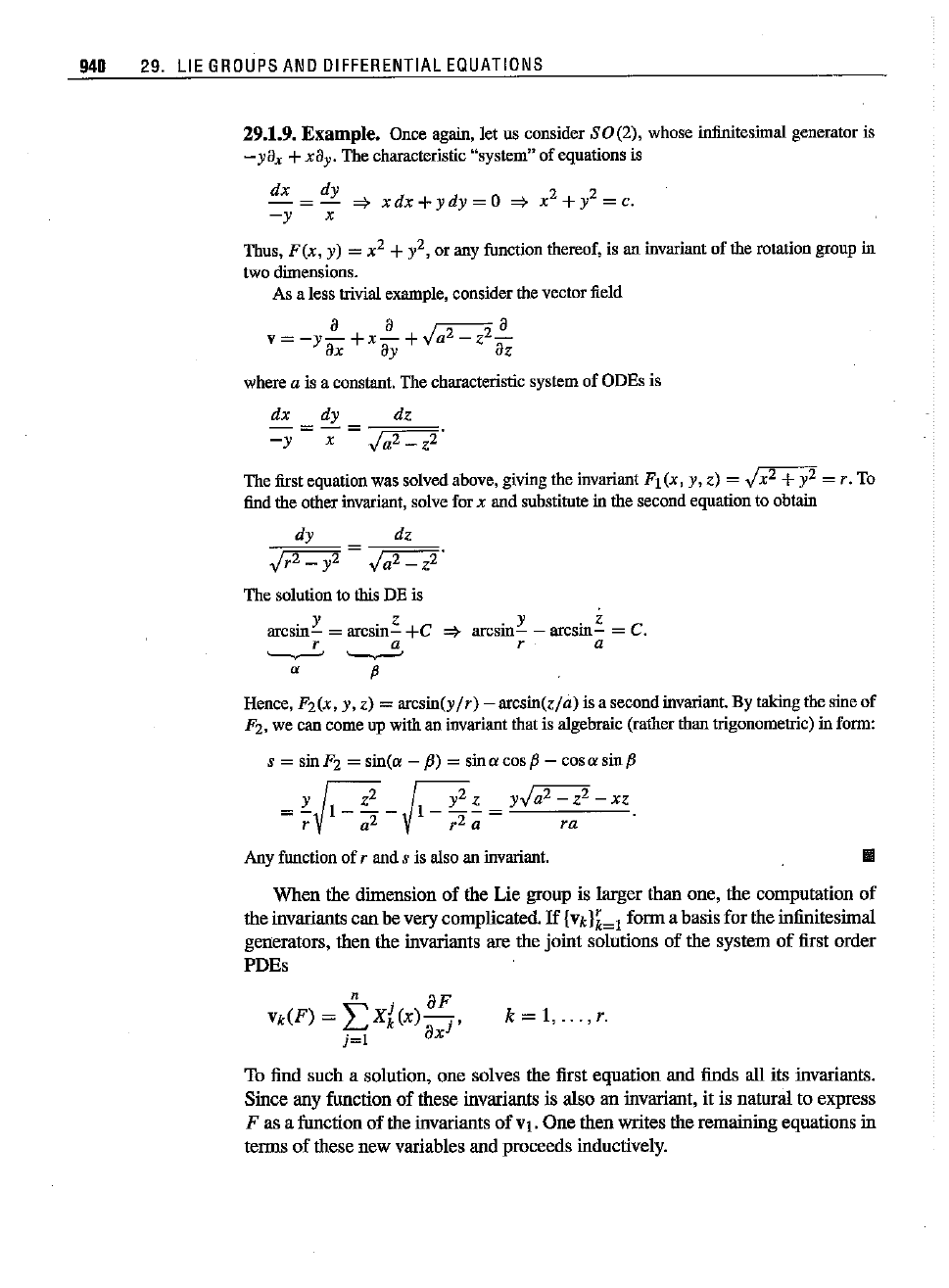
940 29" LIE
GROUPS
AND
DIFFERENTIAL
EQUATIONS
29.1.9.
Example.
Once again,let us consider SO(2), whose infinitesimalgeneratoris
-ya
x
+xayoThe characteristic "system"
of
equations is
dx
-y
=>
arcsin
~
- arcsin':' = C.
r a
Thus, F (x, y) = x
2
+y2, or any function thereof. is an invariant of the rotation group in
two dimensions.
As a less trivial example, considerthe vector field
v=
-y~
+x~
+Ja
2
-z2~
ax ay az
wherea is a constant.Thecharacteristicsystemof ODEsis
dx dy dz
-y
=7 =
Ja2-z2"
The first equation was solved above, giving the invariant
Fl
(x, y, z) =
Jx
2
+y2 =
r,
To
find
the otherinvariant, solve for x and substitute in the second equation to obtain
dy dz
Jr
2_
y2
=
Ja
2-z
2"
The solutionto this DEis
arcsin
~
= arcsin
~
+C
r a
'-..-'
'-..-'
a p
Hence, F2(X,y, z) = arcsin(yjr)
-arcsin(zja)
is a secondinvariant. By takingthesineof
Fl.
we can come up with an invariant that is algebraic (ratherthan trigonometric) in form:
s
= sin
Fl
=
sin(a
-
fJ)
=sin a cos
fJ
- cos a sin
fJ
=~.Jl_z2
_jl_y2~=y~-xz"
r a
2
r
2
a ra
Any functionof r and s is also an invariant.
II
k = 1,
..
.,».
When
the dimension
of
the
Lie
group is larger than one, the computation
of
the invariants can be very complicated.
If
{vdk=1 form a basisfor the infinitesimal
generators, then the invariants are the
joint
solutions
of
the system
of
first order
PDEs
n .
aF
vk(F)
=
LX£(x)j'
j=!
ax
To find such a solution, one solves the first equation and finds all its invariants.
Since any function
of
these invariants is also an invariant, it is natural to express
F as a function
of
the invariants
of
VI.
One
then writes the remaining equations in
terms
of
these new variables and proceeds inductively.

29.2
SYMMETRY
GROUPS
OF
OIFFERENTIAL
EQUATIONS
941
29.1.10.
Example.
Considerthe vectorfields
u =
-y8
x
+x8
y,
_
(X
3
z
+x
y
2z+a
3x)
8
(X
2yZ
+y3
Z
+a
3
y)
_
(~+
2 2 b
3)
8
v-
~
x+
~
8
y
yX--j-y-z
+ e
yX-+y-
yX-+y-
where a
and
b are constants. The invariants
ofu
are functions
of
r =
.,j
xl
+y2 and z.
If
we
are to have a nontrivial solution, the invariant
of
v as
well
as its
PDE
should be expressible
in
tenus
of
r =
.J
xl
+y2 and z. The reader
may
verify that
with the characteristic equation
dr dz
Thisis an exactfirst-order DE whosesolutions are givenby
!r
2z
2
+a
3z
+b
3
r = c
with c an arbitrary constant. Therefore, F =
!r2z2
+a
3z
+ b
3r,
or
F(x,y,z)
=
!(x2+y2)z2+a3z+b3Jx2+y2,
or a function thereof, is the single invariant
of
this group.
29.2 Symmetry Groups of Differential Equations
III
Let
Sbe a system
of
partialdifferentialequationsiuvolvingp independentvariables
x =
(xl,
...
, x
P),
and q dependent variables u = (u
l,
...
, u
q
).
The solutions
of
the systemare
of
the formu =
f(x),
or, in componentform, u" =
f(x
l
,
•••
, x
P
),
a =
I,
...
, q.
Let
X =
ffi,P
and U =
ffi,q
be the spaces
of
independent and depen-
dent variables with coordinates
{xi}
and
{u·},
respectively. Rougbly speaking, a
symmetry group
of
the system S will be a local group
of
transformations that
map
solutions
of
S into solutions
of
S.
Marius Sephus Lie
(1842-1899) was the youngestson of a Lutheranpastor in
Norway.
He studied mathematics and science at Christiania (which became Kristiania, then Oslo
in 1925) University where he attended Sylow's lectures on group theory. There followed a
few years when he could
not
decide what career to follow. He tutored privately after his
graduation and even dabbled a
bit
in astronomy and mechanics.
Aturningpointcamein 1868 whenhereadpaperson geometryby
Poncelet
and
Plucker
from
which
originatedthe inspiration in the topic
of
creating geometries by using elements
other than points in space,
and
provided the
seed
for the
rest
of
Lie's
career, prompting
him
to call
himself
a student
of
Plucker, even though the two
had
never met.
Lie's
first
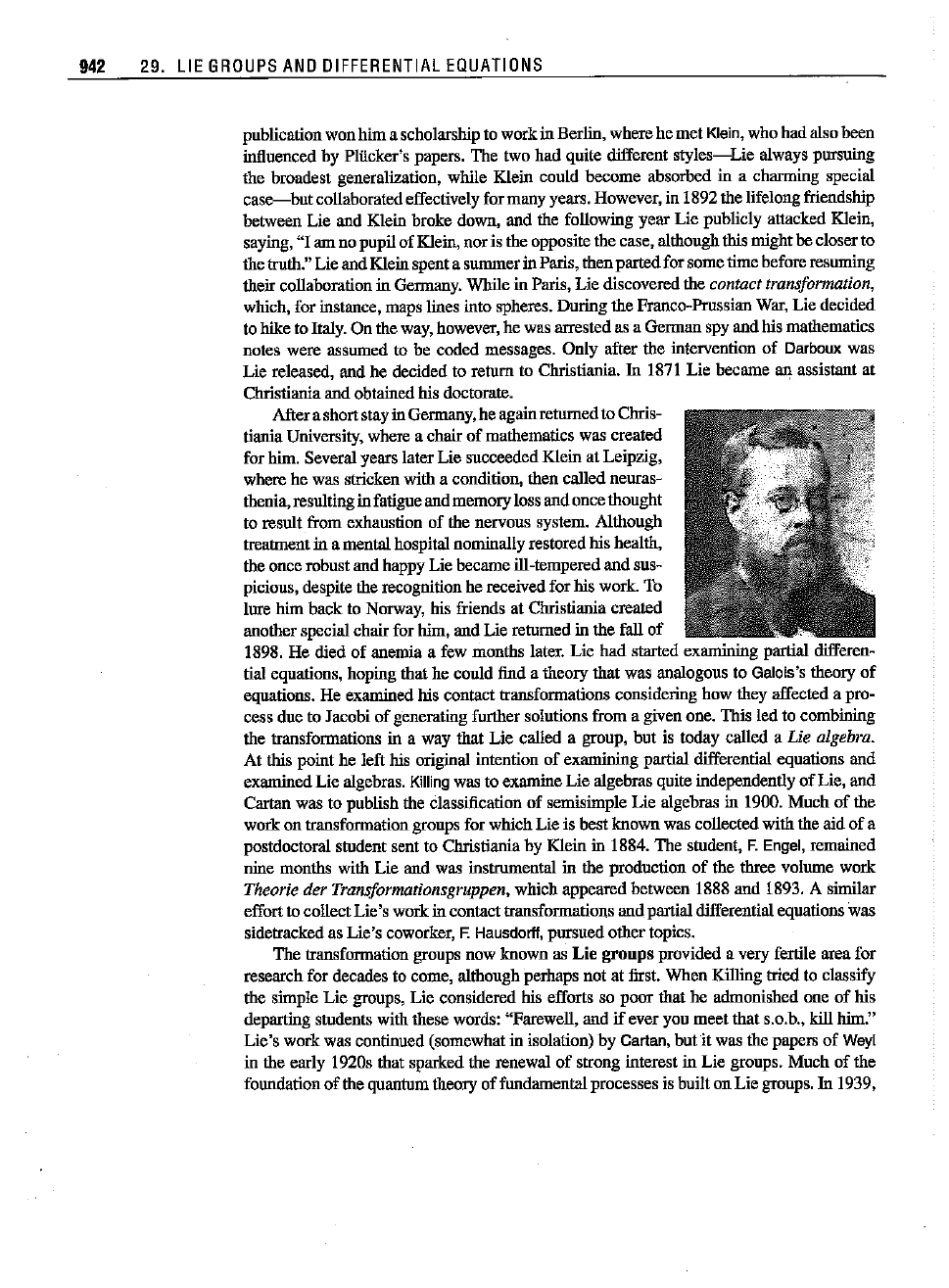
942
29. LIE
GROUPS
AND
DIFFERENTIAL
EQUATIONS
publicationwonhimascholarshiptoworkinBerlin,wherehemet
Klein,
whohadalsobeen
influenced by Plucker's papers. The two had quite different
styles-Lie
always pursuing
the broadest generalization, while Klein could become absorbed
in a charming special
case-but
collaboratedeffectively for
many
years. However, in 1892
the
lifelongfriendship
between Lie and Klein broke down, and the following year Lie publicly attacked Klein,
saying, "1am no pupil of Klein,
nor
is the opposite the case, although this mightbecloserto
thetruth." LieandKleinspentasummerinParis,thenpartedforsometimebeforeresuming
their collaboration in Gennany. While in Paris,
Lie
discovered the contact transformation,
which,
for
instance,
maps
lines
into
spheres.
During
the
Franco-Prussian War,
Lie
decided
to hike to Italy. On the way, however, he was arrestedas a German spy and his mathematics
notes were assumed to be coded messages. Only after the intervention
of
Darboux was
Lie released,
andhe decided to return to Christiania.
In
1871 Lie became an assistant at
Christiania and obtained his doctorate.
Afterashortstay in Germany, he againretumedto Chris-
tiania University, where a chair
of
mathematics was created
for him. Several years later Lie succeededKlein at Leipzig,
where he was stricken with a condition, then called neuras-
thenia, resulting
infatigue and memoryloss and once thought
to result from exhaustion
of
the nervous system. Although
treatmentin a mental hospital nominally restoredhis health,
the once robust and happy Lie became ill-tempered and sus-
picious, despite the recognition he received for his work. To
lure him
back
to Norway, his friends at Christiania created
another special chair for him, and Lie returned in the fall
of
1898. He died
of
anemia a few months later. Lie
had
started examining partial differen-
tial equations, hoping that he could find a theory that was analogous to Galois's theory
of
equations. He examined his contact transformations considering how they affected a pro-
cess due to Jacobi
of
generating further solutions from a given one. This led to combining
the transformations in a way that
Lie
called a group, but is today called a Lie algebra.
At this point he left his original intention
of
examining partial differential equations and
examinedLie algebras.
Killing
was to examine Lie algebras quite independently
of
Lie, and
Cartan was to publish the classification of semisimple
Lie
algebras in 1900. Much
of
the
work on transformation groups for whichLie is bestknown was collected with the aid
of
a
postdoctoral student sent to Christiania by Klein in 1884. The student,
F.Engel, remained
nine months with Lie and was instrumental in the production
of
the three volume work
Theorie der Transformationsgruppen; which appeared between 1888 and 1893. A similar
effortto collectLie's work in contacttransformations and partial differential equations was
sidetracked as
Lie's
coworker, F.Hausdorff, pursued other topics.
The transformation groups now known as
Lie
groups
provided a very fertile area for
research for decades to come, although perhaps not at first. When Killing tried to classify
the simple
Lie
groups, Lie considered his efforts so poor that he admonished one
of
his
departing students with these words: "Farewell, and
if
ever you meet that s.o.b.,
kill
him."
Lie's work was continued (somewhat in isolation) by Cartan, but
it
was the papers
of
Way!
in the early 1920s that sparked the renewal
of
strong interest in Lie groups. Much of the
foundationof thequantumtheoryof fundamentalprocessesis builton Liegroups.In 1939,
